HISTORY
- GOJOSEON
- THREE KINGDOMS AND GAYA
- UNIFIED SILLA AND BALHAE
- GORYEO
- JOSEON
- KOREA EMPIRE
- FOUNDING OF THE REPUBLIC
GOJOSEON
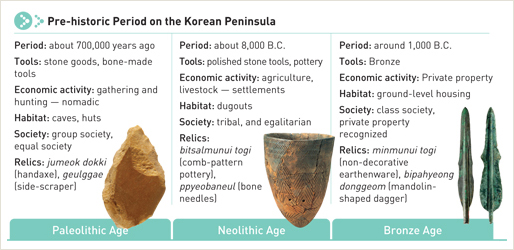
People began living on the Korean Peninsula and its surrounding areas from some 700,000 years ago.
The Neolithic Age began some 8,000 years ago. Relics from that period can be found in areas throughout the Korean Peninsula, mostly in coastal areas and in areas near big rivers.
The Bronze Age began around 1,500 to 2,000 B.C. in present-day Mongolia and on the peninsula.
As this civilization began to form, numerous tribes appeared in the Lioaning region of Manchuria and in northwestern Korea. These tribes were ruled by leaders, whom Dangun, the legendary founder of the Korean people, later united to establish Gojoseon (2333 B.C.). The founding date is a testament to the longevity of Korea's history. This heritage is also a source of pride that provides Koreans the strength to persevere in times of adversity.
Three Kingdoms and Gaya
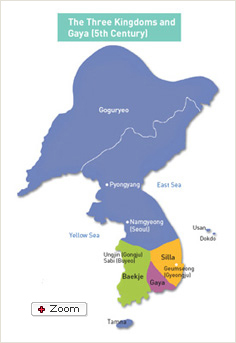
(5th century)
Town-states gradually united into tribal leagues with complex political structures which eventually grew into kingdoms. Among various tribal leagues, Goguryeo (37 B.C.- A.D. 668), situated along the middle course of the Amnokgang River (Yalu River), was the first to mature into a kingdom.
Goguryeo's aggressive troops conquered neighboring tribes one after another, and in 313, they even occupied China's Lolang outposts.
Baekje (18 B.C.-A.D. 660), which grew out of a town-state located south of the Hangang River in the vicinity of present-day Seoul, was another confederated kingdom similar to Goguryeo. During the reign of King Geunchogo (r. 346-375), Baekje developed into a centralized and aristocratic state.
Silla (57 B.C.-A.D. 935) was located in the southeast corner of the peninsula and was initially the weakest and most underdeveloped of the three kingdoms.
However, because it was geographically removed from Chinese influence, it was more open to non-Chinese practices and ideas. Its society was built on an advanced Buddhist order that was markedly class-oriented, including a military that featured a unique corps of young aristocratic warriors called Hwarang.
Gaya (42-562) began as a type of confederation, formed when several tribes from the Nakdonggang River came together.
Unified Silla and Balhae
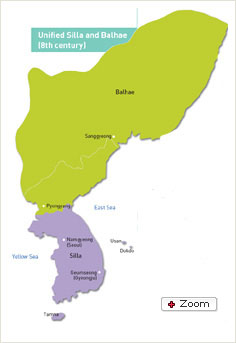
(8th century)
By the mid-sixth century, the Silla Kingdom had brought under its control all of the neighboring town-states within the Gaya Confederation.
Through an alliance with the Tang Dynasty of China, Silla unified the Korean Peninsula in 668 and saw the zenith of its power and prosperity in the mid-eighth century. It attempted to establish an ideal Buddhist country. Bulguksa Temple was constructed during the Unified Silla period. However, its Buddhist social order began to deteriorate as the nobility indulged in increasing luxury.
Silla had repelled Tang attempts to subjugate Goguryeo and Baekje by 676. Then in 698, the former people of Goguryeo who resided in south-central Manchuria established the Kingdom of Balhae. Balhae included not only people of Goguryeo, but also a large Malgal population.
Balhae established a government system centered around five regional capitals, which was modeled after the Goguryeo Kingdom's administrative structure. Balhae possessed an advanced culture which was rooted in that of Goguryeo.
Balhae prosperity reached its height in the first half of the ninth century with the occupation of a vast territory reaching to the Amur River in the north and Kaiyuan in south-central Manchuria to the west. It also established diplomatic ties with Turkey and Japan. Balhae existed until 926, when it was overthrown by the Khitan. Many of the Balhae nobility, who were mostly Goguryeo descendants, moved south and joined the newly founded Goryeo Dynasty.
Goryeo
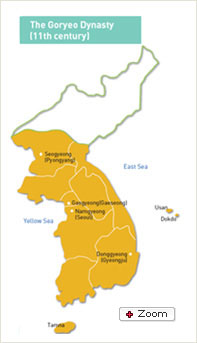
(11th century)
The Goryeo Dynasty (918-1392) was founded by Wang Geon, a general who had served under Gungye, a rebel prince of the Silla Kingdom. Choosing his native town of Songak (present-day Gaeseong in North Korea) as the capital, Wang Geon proclaimed the goal of recovering the lost territory of the Goguryeo Kingdom in northeast China.
Wang Geon named his dynasty Goryeo, from which the modern name Korea is derived. Although the Goryeo Dynasty could not reclaim lost lands, it achieved a sophisticated culture represented by cheongja or blue-green celadon and flourishing Buddhist tradition.
No less significant was the invention of the world's first movable metal type in 1234, which preceded the Gutenberg Bible of Germany by two centuries. About that time, skilled Korean artisans also completed the herculean task of carving the entire Buddhist canon on large woodblocks.
These woodblocks, numbering more than 80,000, were intended to invoke the influence of Buddha for the repulsion of the Mongol invaders. Called the Tripitaka Koreana, they are now stored at the historic Haeinsa Temple.
Joseon
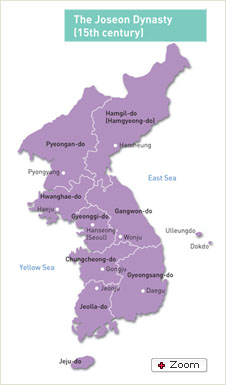
In 1392, General Yi Seong-gye established a new dynasty called Joseon. The early rulers of Joseon, in order to counter the dominant Buddhist influence during the Goryeo period, supported Confucianism as the guiding philosophy of the kingdom.
The Joseon rulers governed the dynasty with a well-balanced political system. A civil service examination system was the main channel for recruiting government officials.
The examinations served as the backbone for social mobility and intellectual activity during the period. The Confucian-oriented society, however, highly valued academic learning while disdaining commerce and manufacturing.
During the reign of King Sejong the Great (1418-1450), Joseon's fourth monarch, Korea enjoyed an unprecedented flowering of culture and art. Under King Sejong's guidance, scholars at the royal academy created the Korean alphabet Hangeul. It was then called Hunminjeongeum, or "proper phonetic system to educate the people."
King Sejong's interest in astronomical science was comprehensive. Sundials, water clocks, celestial globes and astronomical maps were produced at his request. King Sejo (r.1455-1468) later established an institutional framework for government by publishing a compendium of legal codes, called Gyeongguk Daejeon.
In 1592, Japan invaded the peninsula to pave the way for its incursion into China. At sea, Admiral Yi Sun-sin (1545-1598), one of the most respected figures in Korean history, led a series of brilliant naval maneuvers against the Japanese, deploying the geobukseon (turtle ships), which are believed to be the world's first ironclad battleships.
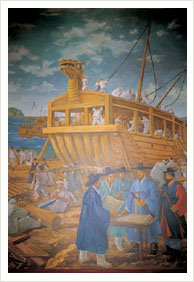
From the early 17th century, a movement advocating Silhak, or practical learning, gained considerable momentum among liberal-minded scholar-officials as a means of building a modern nation.
They strongly recommended agricultural and industrial improvements along with sweeping reforms in land distribution. The conservative government aristocrats, however, were not ready to accommodate such drastic change.
In the latter half of the Joseon era, government administration and the upper classes came to be marked by recurring factionalism. To rectify the undesirable political situation, King Yeongjo (r.1724-1776) eventually adopted a policy of impartiality. He was thus able to strengthen the royal authority and achieve political stability.
King Jeongjo (r.1776-1800) maintained the policy of impartiality and set up a royal library to preserve royal documents and records. He also initiated other political and cultural reforms. This period witnessed the blossoming of Silhak. A number of outstanding scholars wrote progressive works recommending agricultural and industrial reforms, but few of their ideas were adopted by the government.
Korea Empire
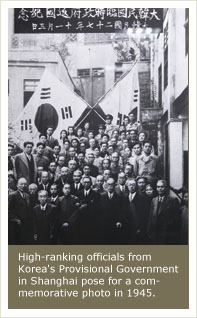
In the 19th century, Korea remained a "Hermit Kingdom," adamantly opposed to Western demands for diplomatic and trade relations. Over time, a few Asian and European countries with imperialistic ambitions competed with each other for influence over the Korean Peninsula.
Japan, after winning wars against China and Russia, forcibly annexed Korea and instituted colonial rule in 1910.
Colonial rule stimulated the patriotism of Koreans. Korean intellectuals were infuriated by Japan's official assimilation policy, which even banned Korean-language education in Korean schools. On March 1, 1919, a peaceful demonstration calling for independence spread nationwide. The Japanese authorities ruthlessly repressed the demonstrators and their supporters, slaughtering thousands.
Although it failed, the March 1 Independence Movement created strong bonds of national identity and patriotism among Koreans. The movement led to the establishment of a Provisional Government in Shanghai, China, as well as an organized armed struggle against the Japanese colonists in Manchuria. The Independence Movement is still commemorated among Koreans every March 1, which is designated a national holiday.
During the colonial period, Japan's economic exploitation of Korea continued. The lives of Koreans deteriorated under colonial rule until the end of World War II in 1945.
Founding of the Republic
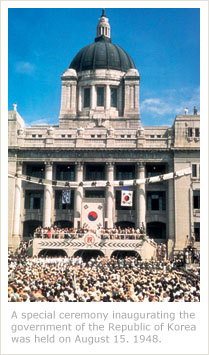
Koreans rejoiced at Japan's World War II defeat. However, their joy was short-lived. Liberation did not instantly bring about the independence for which the Koreans had fought so fiercely. Rather, it resulted in a country divided by ideological differences caused by the emerging Cold War. Korean efforts to establish an independent government were frustrated as U.S. forces occupied the southern half of the peninsula and Soviet troops took control of the north.
In November 1947, the United Nations General Assembly adopted a resolution that called for general elections in Korea under the supervision of a UN Commission.
However, the Soviet Union refused to comply with the resolution and denied the UN Commission access to the northern half of Korea. The UN General Assembly then adopted another resolution calling for elections in areas accessible to its commission.
The first elections in Korea were carried out on May 10, 1948, in the areas south of the 38th parallel. This parallel came to divide the Korean Peninsula into South and North.
Rhee Syng-man was elected the first President of the Republic of Korea in 1948. Meanwhile, north of the 38th parallel, a communist regime was set up under the leadership of Kim Il-sung. On June 25, 1950, North Korea launched an unprovoked full-scale invasion of the South, triggering a three-year war which drew in U.S., Chinese and other foreign forces. The entire peninsula was devastated by the conflict. A cease-fire was signed in July 1953.
Korea's growth-oriented, export-led economic development since the 1960s was so remarkable that it earned the expression "the Miracle on the Hangang River" in the 1970s. Subsequently, Seoul successfully hosted the 24th Olympics in 1988 and Korea co-hosted the 2002 FIFA World Cup Korea/Japan soccer finals with Japan. Through these occasions, Korea has demonstrated to the world its rich cultural heritage and love of art, as well as modern technologies. In the 1950s, Korea ranked among the poorest countries. Today, its economy is around the 13th largest in the world, and the nation is determined to become even more of a global economic leader throughout the new millennium.
The Republic of Korea has steadily followed the path to mature democracy and market economy. Even though the legacies of the Cold War still linger on this peninsula, Korea today is poised to make a new economic take-off. The Koreas are also working toward a durable structure of peace on the peninsula and promoting common prosperity for South and North Korea through peace, reconciliation and cooperation.



 INTERNATIONAL
INTERNATIONAL